Enhanced Nitrite Detection by a Carbon Screen Printed Electrode Modified with Photochemically-Made AuNPs
Abstract
:1. Introduction
2. Materials and Methods
2.1. Apparatus and Chemicals
2.2. Synthesis of AuNPs and Characterization
2.3. Electrode Preparation and Preliminary Nitrite Investigations
3. Results and Discussion
3.1. Structural and Morphological Characterization of AuNPs and CSPE/AuNPs-PEI
3.2. Electrochemical Behaviour of CSPE/AuNPs-PEI Modified Electrode
3.3. Electrocatalytic Activity of CSPE/AuNPs-PEI towards Nitrite Oxidation
3.4. Electrochemical Determination of Nitrite
3.5. Analytical Study
3.6. Reproducibility and Stability
4. Conclusions
Author Contributions
Funding
Acknowledgments
Conflicts of Interest
References
- Wang, Y.; Zeng, Z.; Qiao, J.; Dong, S.; Liang, Q.; Shao, S. Ultrasensitive determination of nitrite based on electrochemical platform of AuNPs deposited on PDDA-modified MXene nanosheets. Talanta 2021, 221, 121605. [Google Scholar] [CrossRef]
- Kanoun, O.; Lazarević-Pašti, T.; Pašti, I.; Nasraoui, S.; Talbi, M.; Brahem, A.; Adiraju, A.; Sheremet, E.; Rodriguez, R.D.; Ali, M.B.; et al. A review of nanocomposite-modified electrochemical sensors for water quality monitoring. Sensors 2021, 21, 4131. [Google Scholar] [CrossRef] [PubMed]
- Han, S.; Chen, X. Copper nanoclusters-enhanced chemiluminescence for folic acid and nitrite detection. Spectrochim. Acta Part A Mol. Biomol. Spectrosc. 2018, 210, 315–320. [Google Scholar] [CrossRef] [PubMed]
- Yang, S.; Liu, X.; Zeng, X.; Xia, B.; Gu, J.; Luo, S.; Mai, N.; Wei, W. Fabrication of nano-copper/carbon nanotubes/chitosan film by one-step electrodeposition and its sensitive determination of nitrite. Sens. Actuators B Chem. 2010, 145, 762–768. [Google Scholar] [CrossRef]
- Ferreira, F.T.S.M.; Mesquita, R.B.R.; Rangel, A.O.S.S. Novel microfluidic paper-based analytical devices (μPADs) for the determination of nitrate and nitrite in human saliva. Talanta 2020, 219, 121183. [Google Scholar] [CrossRef] [PubMed]
- Ridnour, L.A.; Sim, J.E.; Hayward, M.A.; Wink, D.A.; Martin, S.M.; Buettner, G.R.; Spitz, D.R. A spectrophotometric method for the direct detection and quantitation of nitric oxide, nitrite, and nitrate in cell culture media. Anal. Biochem. 2000, 281, 223–229. [Google Scholar] [CrossRef] [Green Version]
- Miranda, K.M.; Espey, M.G.; Wink, D.A. A rapid, simple spectrophotometric method for simultaneous detection of nitrate and nitrite. Nitric Oxide Biol. Chem. 2001, 5, 62–71. [Google Scholar] [CrossRef]
- Kodamatani, H.; Yamazaki, S.; Saito, K.; Tomiyasu, T.; Komatsu, Y. Selective determination method for measurement of nitrite and nitrate in water samples using high-performance liquid chromatography with post-column photochemical reaction and chemiluminescence detection. J. Chromatogr. A 2009, 1216, 3163–3167. [Google Scholar] [CrossRef] [PubMed]
- Helaleh, M.I.H.; Korenaga, T. Ion chromatographic method for simultaneous determination of nitrate and nitrite in human saliva. J. Chromatogr. B Biomed. Sci. Appl. 2000, 744, 433–437. [Google Scholar] [CrossRef]
- Wu, J.; Wang, X.; Lin, Y.; Zheng, Y.; Lin, J. Peroxynitrous-acid-induced chemiluminescence detection of nitrite based on Micro fl uidic chip. Talanta 2016, 154, 73–79. [Google Scholar] [CrossRef] [PubMed]
- Zhao, Z.; Zhang, J.; Wang, W.; Sun, Y.; Hu, J.; Chen, L.; Gong, W. Synthesis and Electrochemical Properties of Co3O4-rGO/CNTs Composites toward Highly Sensitive Nitrite Detection. Appl. Surf. Sci. 2019, 485, 274–282. [Google Scholar] [CrossRef]
- Essousi, H.; Barhoumi, H.; Bibani, M.; Ktari, N.; Wendler, F.; Al-Hamry, A.; Kanoun, O. Ion-Imprinted Electrochemical Sensor Based on Copper Nanoparticles-Polyaniline Matrix for Nitrate Detection. J. Sens. 2019, 4257125. [Google Scholar] [CrossRef] [Green Version]
- Talbi, M.; Al-Hamry, A.; Rios, P.; Bouhamed, A.; Azzouzi, S.; Paterno, L.G.; Ben, M. Graphite Screen Printed Electrodes Functionalized with AuNPs-PEI for Nitrite Detection. In Proceedings of the International Multi-Conference on Systems, Signals & Devices (SSD), Istanbul, Turkey, 21–24 March 2019; IEEE: Piscataway, NJ, USA, 2019; 4, pp. 2019–2022. [Google Scholar]
- Nasraoui, S.; Al-Hamry, A.; Teixeira, P.R.; Paterno, L.G.; Ali, M.B.; Kanoun, O. Electrochemical sensor for nitrite detection in water samples using flexible laser-induced graphene electrodes functionalized by CNT decorated by Au nanoparticles. J. Electroanal. Chem. 2020, 880, 114893. [Google Scholar] [CrossRef]
- Beaver, K.; Dantanarayana, A.; Minteer, S.D. Materials Approaches for Improving Electrochemical Sensor Performance. J. Phys. Chem. B 2021, 125, 11820–11834. [Google Scholar] [CrossRef] [PubMed]
- Keçili, R.; Denizli, A. Molecular Imprinting-Based Smart Nanosensors for Pharmaceutical Applications. In Molecular Imprinting for Nanosensors and Other Sensing Applications; Elsevier Inc.: Amsterdam, The Netherlands, 2021; ISBN 9780128221174. [Google Scholar] [CrossRef]
- Alam, A.U.; Deen, M.J. Bisphenol A Electrochemical Sensor Using Graphene Oxide and β-Cyclodextrin-Functionalized Multi-Walled Carbon Nanotubes. Anal. Chem. 2020, 92, 5532–5539. [Google Scholar] [CrossRef]
- Manikandan, V.S.; Adhikari, B.R.; Chen, A. Nanomaterial based electrochemical sensors for the safety and quality control of food and beverages. Analyst 2018, 143, 4537–4554. [Google Scholar] [CrossRef]
- Andreoli, E.; Annibaldi, V.; Rooney, D.A.; Liao, K.S.; Alley, N.J.; Curran, S.A.; Breslin, C.B. Electrochemical conversion of copper-based hierarchical micro/nanostructures to copper metal nanoparticles and their testing in nitrate sensing. Electroanalysis 2011, 23, 2164–2173. [Google Scholar] [CrossRef] [Green Version]
- Rastogi, P.K.; Ganesan, V.; Krishnamoorthi, S. A promising electrochemical sensing platform based on a silver nanoparticles decorated copolymer for sensitive nitrite determination. J. Mater. Chem. A 2014, 2, 933–943. [Google Scholar] [CrossRef]
- Bagheri, H.; Hajian, A.; Rezaei, M.; Shirzadmehr, A. Composite of Cu metal nanoparticles-multiwall carbon nanotubes-reduced graphene oxide as a novel and high performance platform of the electrochemical sensor for simultaneous determination of nitrite and nitrate. J. Hazard. Mater. 2017, 324, 762–772. [Google Scholar] [CrossRef] [PubMed]
- Abdel Hameed, R.M.; Medany, S.S. Sensitive nitrite detection at core-shell structured Cu@Pt nanoparticles supported on graphene. Appl. Surf. Sci. 2018, 458, 252–263. [Google Scholar] [CrossRef]
- Chauhan, N.; Pundir, C.S. An amperometric biosensor based on acetylcholinesterase immobilized onto iron oxide nanoparticles/multi-walled carbon nanotubes modified gold electrode for measurement of organophosphorus insecticides. Anal. Chim. Acta 2011, 701, 66–74. [Google Scholar] [CrossRef] [PubMed]
- Guo, S.; Wang, E. Synthesis and electrochemical applications of gold nanoparticles. Anal. Chim. Acta 2007, 598, 181–192. [Google Scholar] [CrossRef] [PubMed]
- Daniel, M.; Astruc, D. Gold Nanoparticles: Assembly, Supramolecular Chemistry, Quantum-Size-Related Properties, and Applications toward Biology, Catalysis, and Nanotechnology. Chem. Rev. 2004, 104, 293–346. [Google Scholar] [CrossRef]
- Afkhami, A.; Soltani-Felehgari, F.; Madrakian, T.; Ghaedi, H. Surface decoration of multi-walled carbon nanotubes modified carbon paste electrode with gold nanoparticles for electro-oxidation and sensitive determination of nitrite. Biosens. Bioelectron. 2014, 51, 379–385. [Google Scholar] [CrossRef]
- Rao, H.; Liu, Y.; Zhong, J.; Zhang, Z.; Zhao, X.; Liu, X.; Jiang, Y.; Zou, P.; Wang, X.; Wang, Y. Gold Nanoparticle/Chitosan@N,S Co-doped Multiwalled Carbon Nanotubes Sensor: Fabrication, Characterization, and Electrochemical Detection of Catechol and Nitrite. ACS Sustain. Chem. Eng. 2017, 5, 10926–10939. [Google Scholar] [CrossRef]
- Chen, H.; Yang, T.; Liu, F.; Li, W. Electrodeposition of gold nanoparticles on Cu-based metal-organic framework for the electrochemical detection of nitrite. Sens. Actuators B Chem. 2018, 286, 401–407. [Google Scholar] [CrossRef]
- Kang, S.; Zhang, H.; Wang, G.; Zhang, Y.; Zhao, H.; Zhou, H.; Cai, W. Highly sensitive detection of nitrite by using gold nanoparticles-decorated α-Fe2O3 nanorod arrays as self-supporting photo-electrodes. Inorg. Chem. Front. 2019, 6, 1432–1441. [Google Scholar] [CrossRef]
- Yu, H.; Li, R.; Song, K.-l. Amperometric determination of nitrite by using a nanocomposite prepared from gold nanoparticles, reduced graphene oxide and multi-walled carbon nanotubes. Microchim. Acta 2019, 186, 624. [Google Scholar] [CrossRef] [PubMed]
- Balasubramanian, P.; Balamurugan, T.S.T.; Chen, S. Highly Sensitive Electrochemical Detection of Nitrite Ions in Food Samples via β -Cyclodextrin Capped Gold Nanoparticles Film Modified Glassy Carbon Electrode. J. Electrochem. Soc. 2017, 164, 715–722. [Google Scholar] [CrossRef]
- Li, X.; Zou, N.; Wang, Z.; Sun, Y.; Li, H.; Gao, C.; Wang, T.; Wang, X. An electrochemical sensor for determination of nitrite based on Au nanoparticles decorated MoS2 nanosheets. Chem. Pap. 2020, 74, 441–449. [Google Scholar] [CrossRef]
- Teixeira, P.R.; Santos, M.S.; Silva, A.L.G.; Báo, S.N.; Azevedo, R.B.; Sales, M.J.A.; Paterno, L.G. Photochemically-Assisted Synthesis of Non-toxic and Biocompatible Gold Nanoparticles. Colloids Surf. B Biointerfaces 2016, 148, 317–323. [Google Scholar] [CrossRef]
- Borkovec, M.; Koper, G.J.M. Proton Binding Characteristics of Branched Polyelectrolytes. Macromolecules 1997, 30, 2151–2158. [Google Scholar] [CrossRef]
- Davey, W.P. Precision measurements of the lattice constants of twelve common metals. Phys. Rev. 1925, 25, 538. [Google Scholar] [CrossRef]
- Broder, T.L.; Silvester, D.S.; Aldous, L.; Hardacre, C.; Compton, R.G. Electrochemical oxidation of nitrite and the oxidation and reduction of NO2 in the room temperature ionic liquid [C2mim][NTf 2]. J. Phys. Chem. B 2007, 111, 7778–7785. [Google Scholar] [CrossRef]
- Sahoo, S.; Sahoo, P.K.; Sharma, A.; Satpati, A.K. Interfacial polymerized RGO/MnFe2O4/polyaniline fibrous nanocomposite supported glassy carbon electrode for selective and ultrasensitive detection of nitrite. Sens. Actuators B Chem. 2020, 309, 127763. [Google Scholar] [CrossRef]
- Keita, B.; Essaadi, K.; Nadjo, L.; Desmadril, M. Rate-limiting one-electron transfer in the oxidation of NADH by polyoxometalates. Chem. Phys. Lett. 1995, 237, 411–418. [Google Scholar] [CrossRef]
- Piela, B.; Piela, P.; Wronaa, P.K. Oxidation of nitrite on solid electrodes: II. Determination of the reaction mechanism on surfaces covered by an oxide layer. J. Electrochem. Soc. 2002, 149, 357–366. [Google Scholar] [CrossRef]
- Jian, J.M.; Fu, L.; Ji, J.; Lin, L.; Guo, X.; Ren, T.L. Electrochemically reduced graphene oxide/gold nanoparticles composite modified screen-printed carbon electrode for effective electrocatalytic analysis of nitrite in foods. Sens. Actuators B Chem. 2018, 262, 125–136. [Google Scholar] [CrossRef]
- Han, Y.; Zhang, R.; Dong, C.; Cheng, F.; Guo, Y. Sensitive electrochemical sensor for nitrite ions based on rose-like AuNPs/MoS2/ graphene composite. Biosens. Bioelectron. 2019, 142, 111529. [Google Scholar] [CrossRef] [PubMed]
- He, B.; Yan, D. Au/ERGO nanoparticles supported on Cu-based metal-organic framework as a novel sensor for sensitive determination of nitrite. Food Control 2019, 103, 70–77. [Google Scholar] [CrossRef]
- Losada, J.; García Armada, M.P.; García, E.; Casado, C.M.; Alonso, B. Electrochemical preparation of gold nanoparticles on ferrocenyl-dendrimer film modified electrodes and their application for the electrocatalytic oxidation and amperometric detection of nitrite. J. Electroanal. Chem. 2017, 788, 14–22. [Google Scholar] [CrossRef]
- Rostami, M.; Abdi, G.; Habib, S.; Alizadeh, A. Nanocomposite of magnetic nanoparticles/graphene oxide decorated with acetic acid moieties on glassy carbon electrode: A facile method to detect nitrite concentration. J. Electroanal. Chem. 2019, 847, 113239. [Google Scholar] [CrossRef]

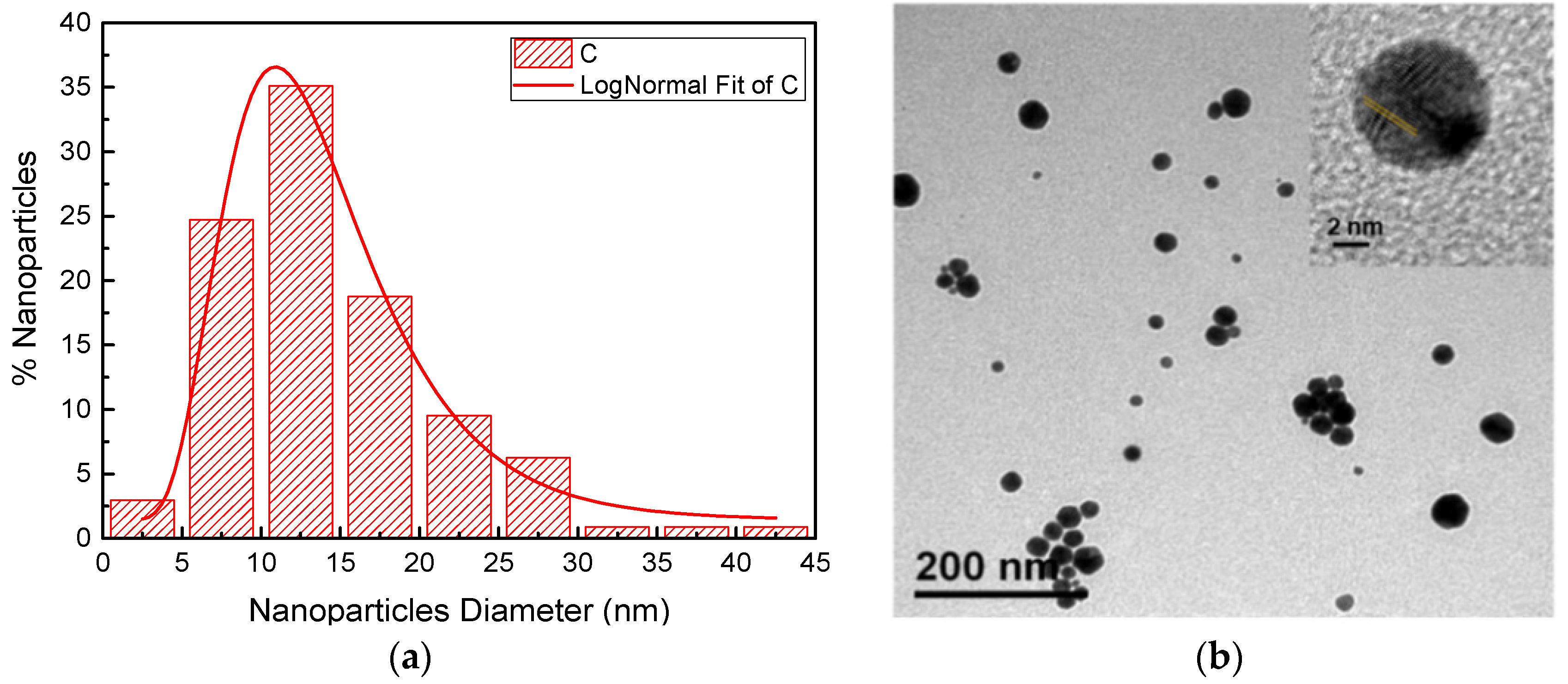
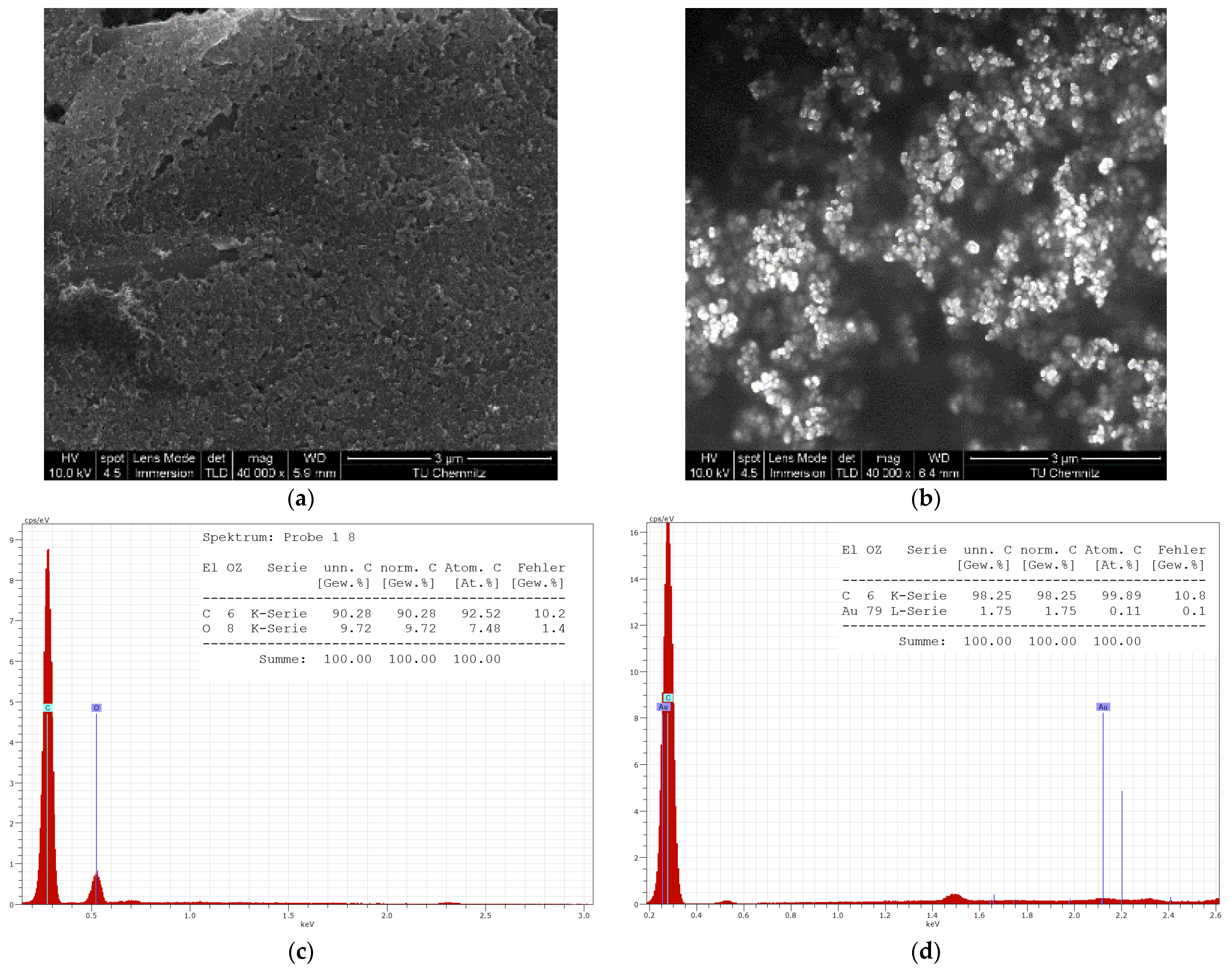
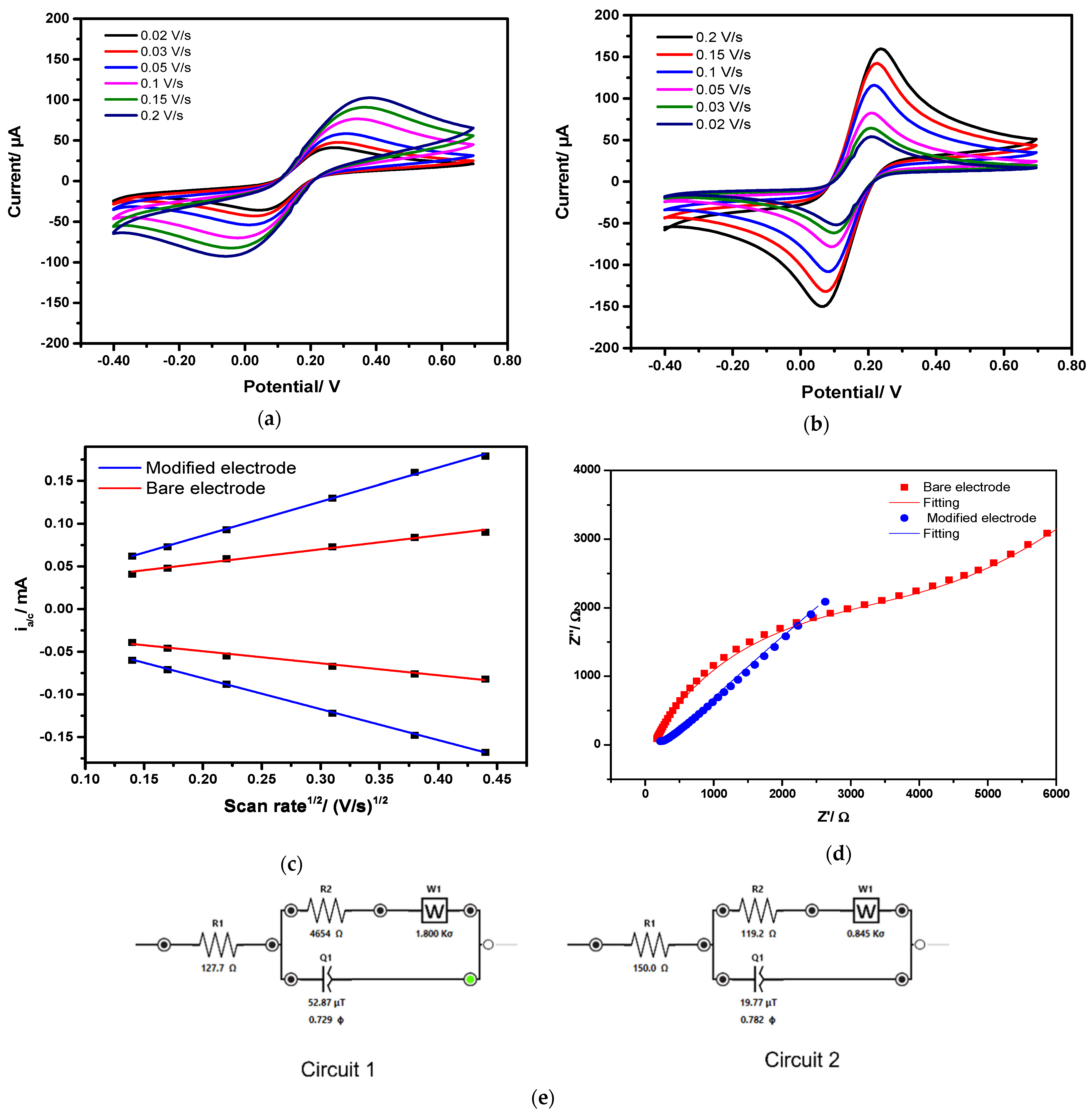
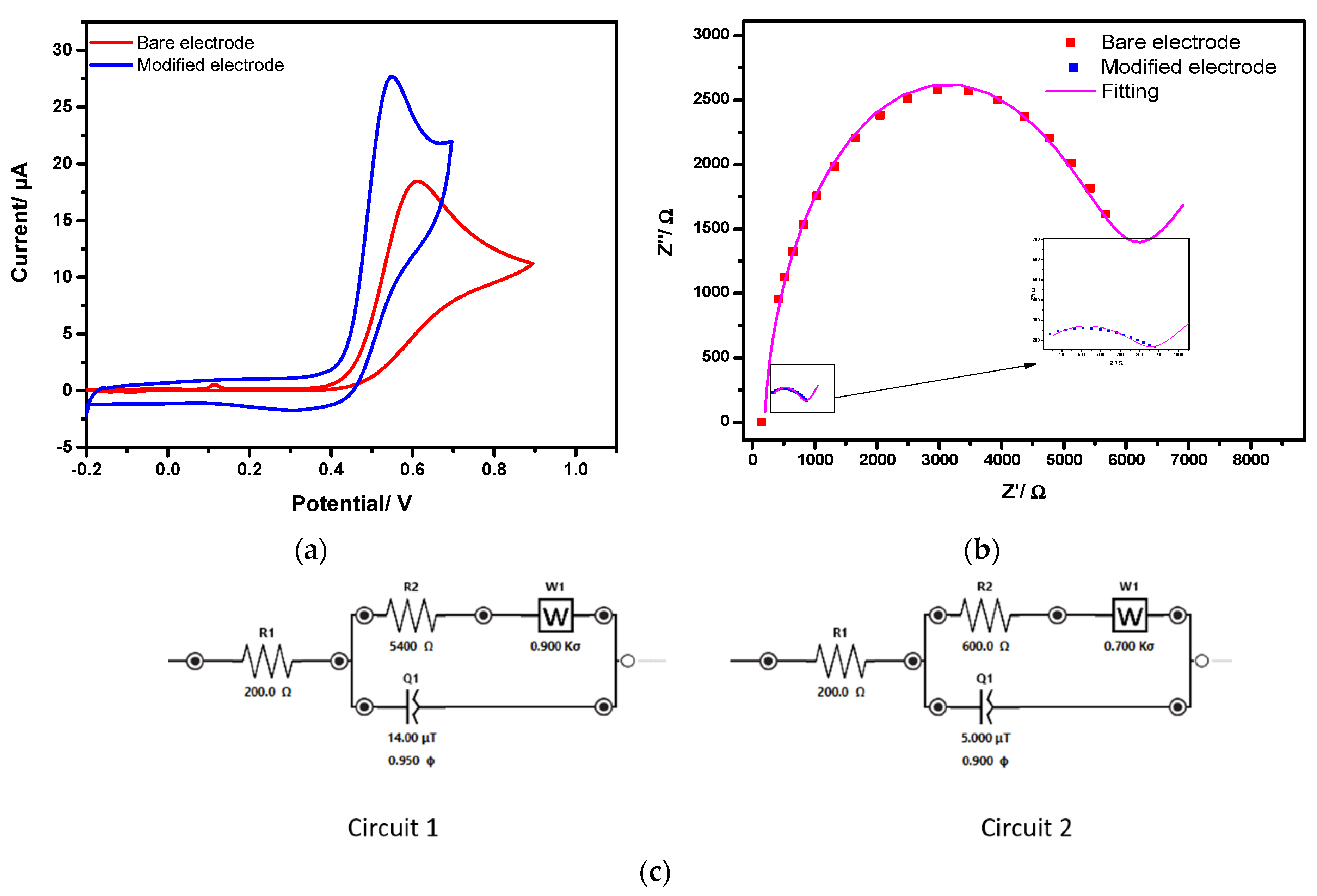
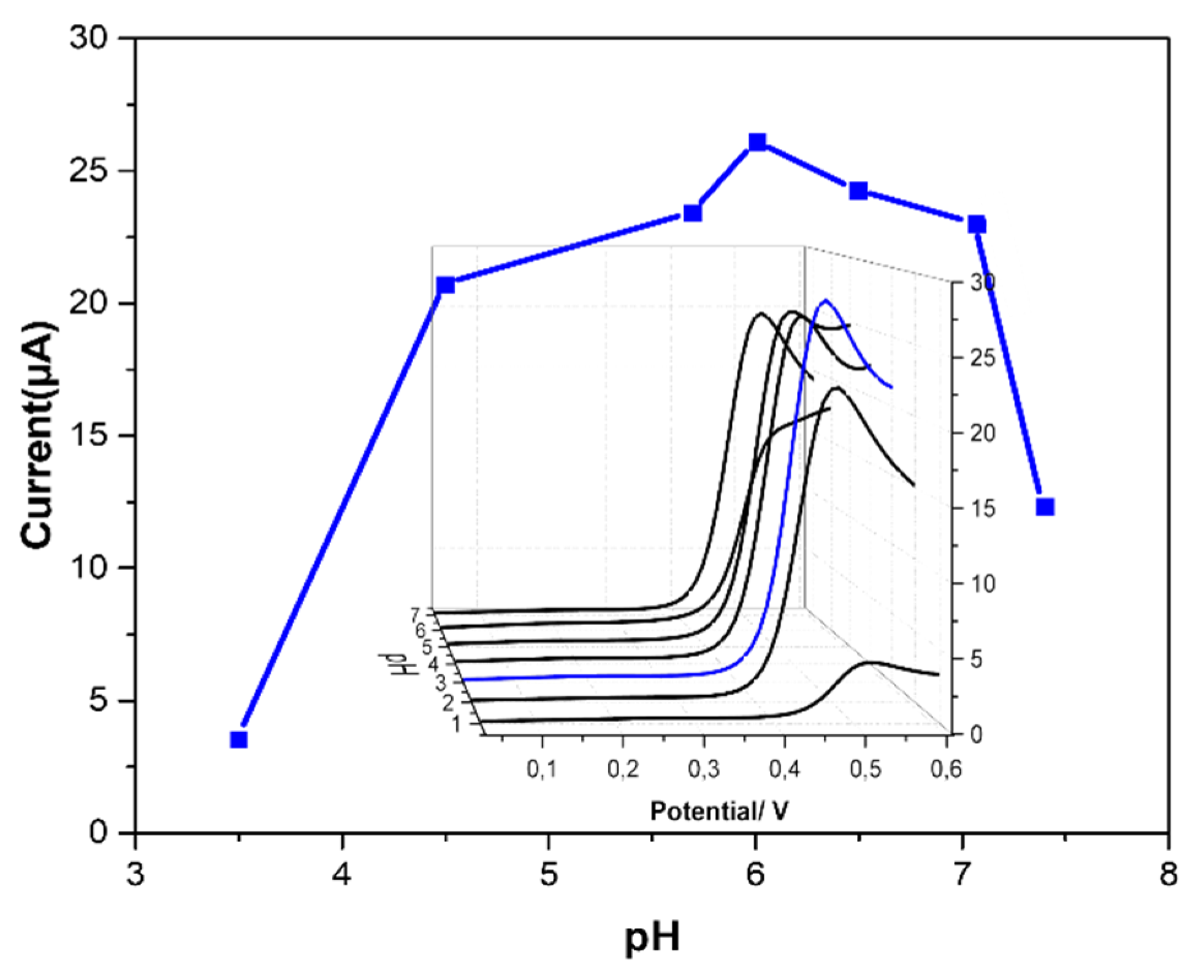
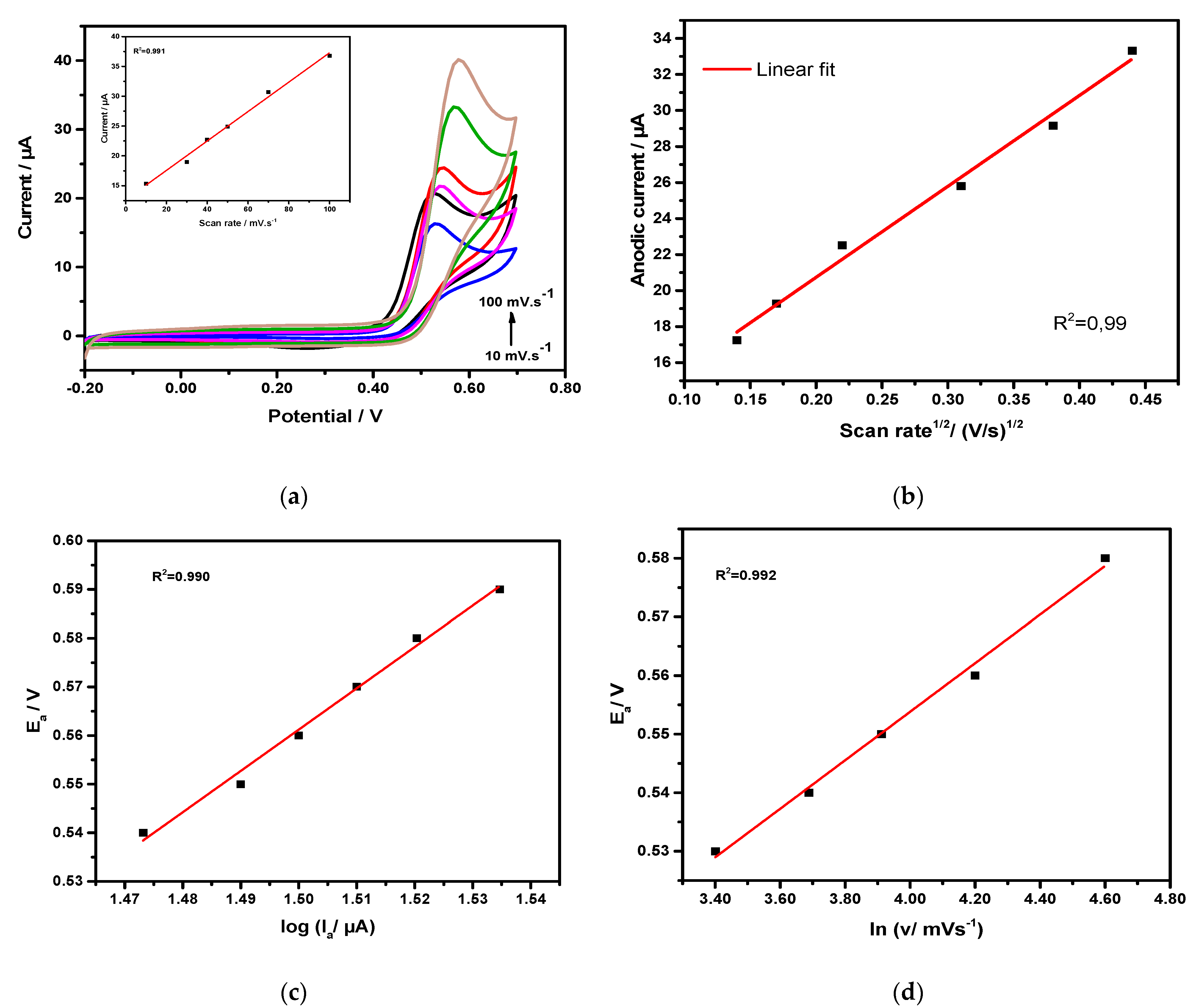
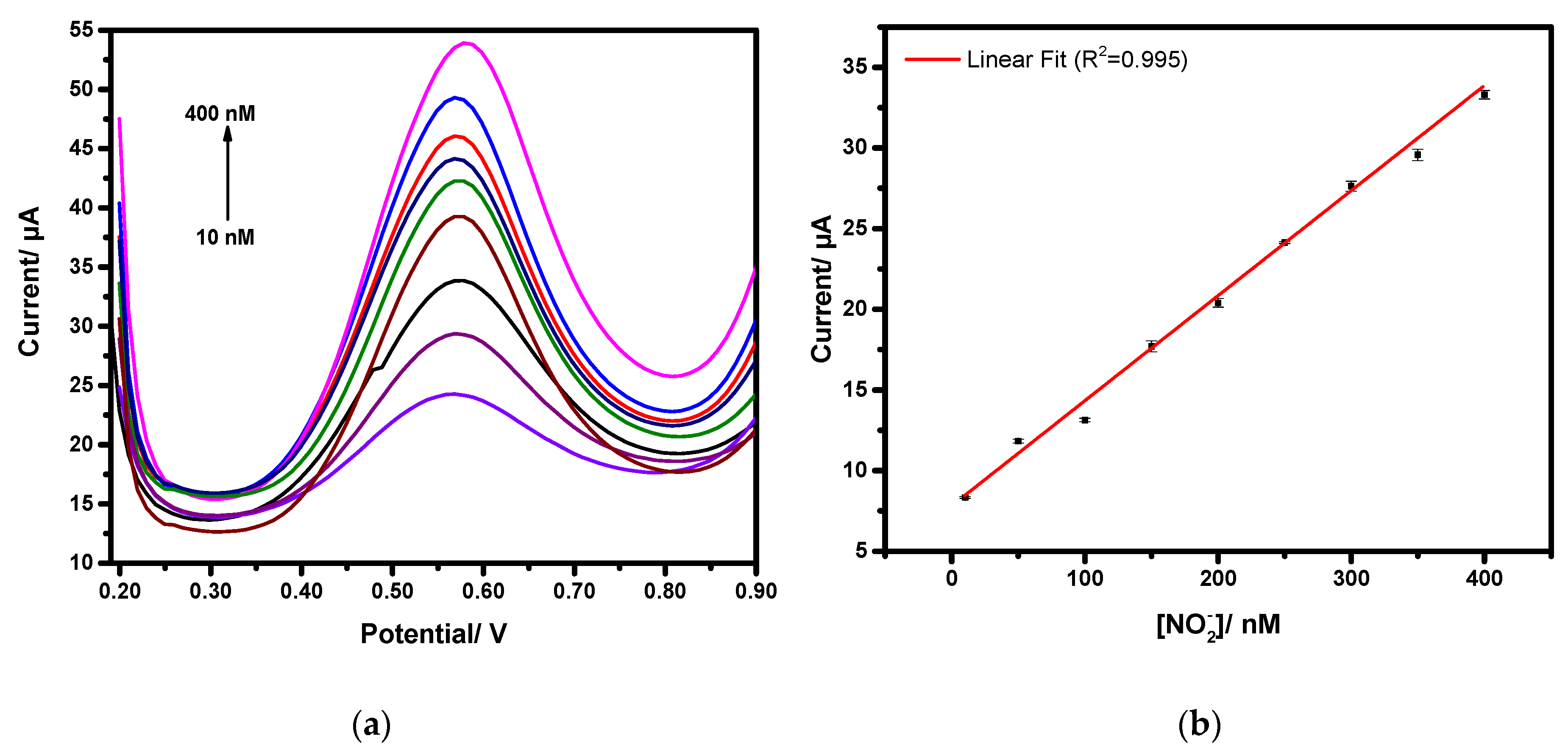
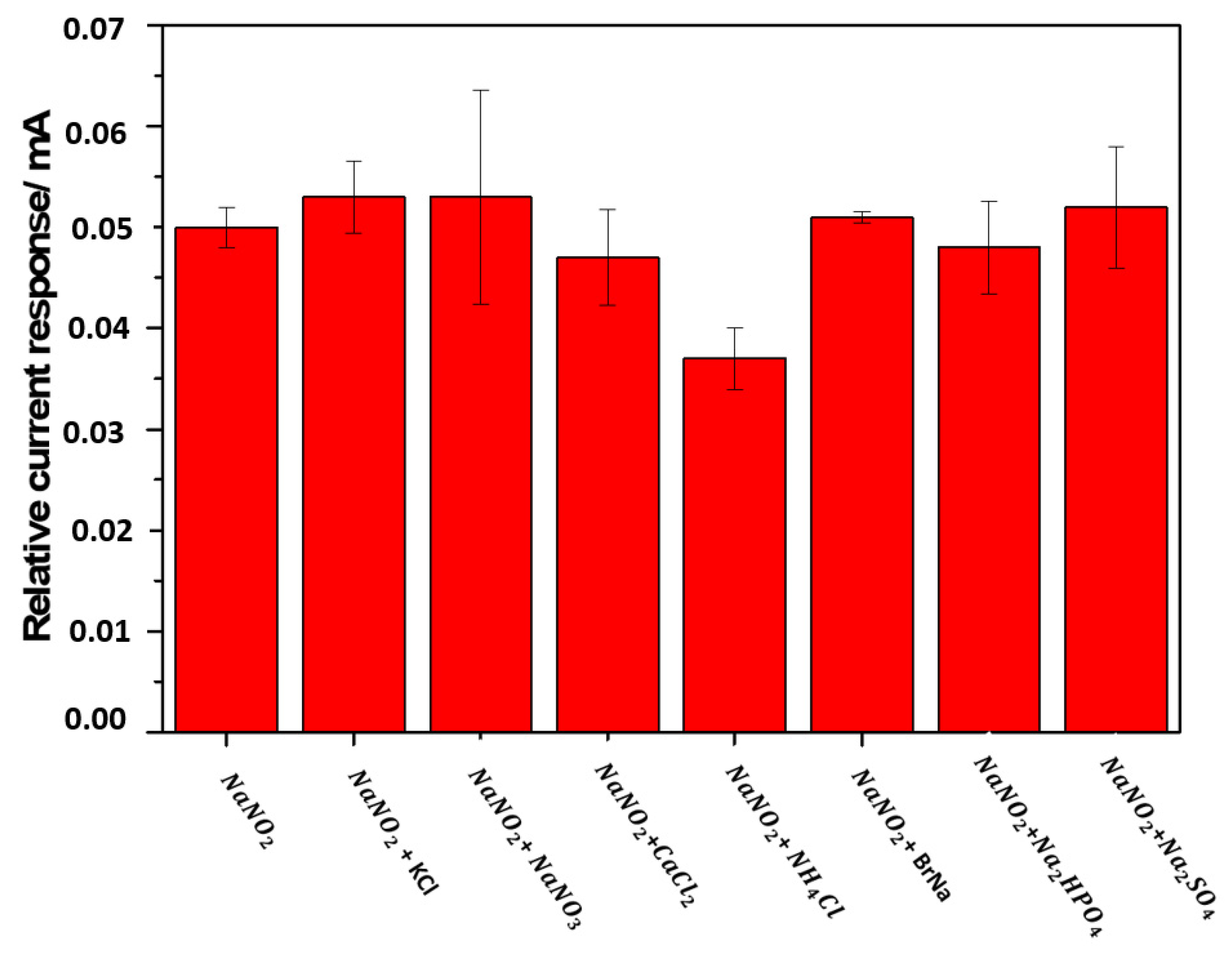
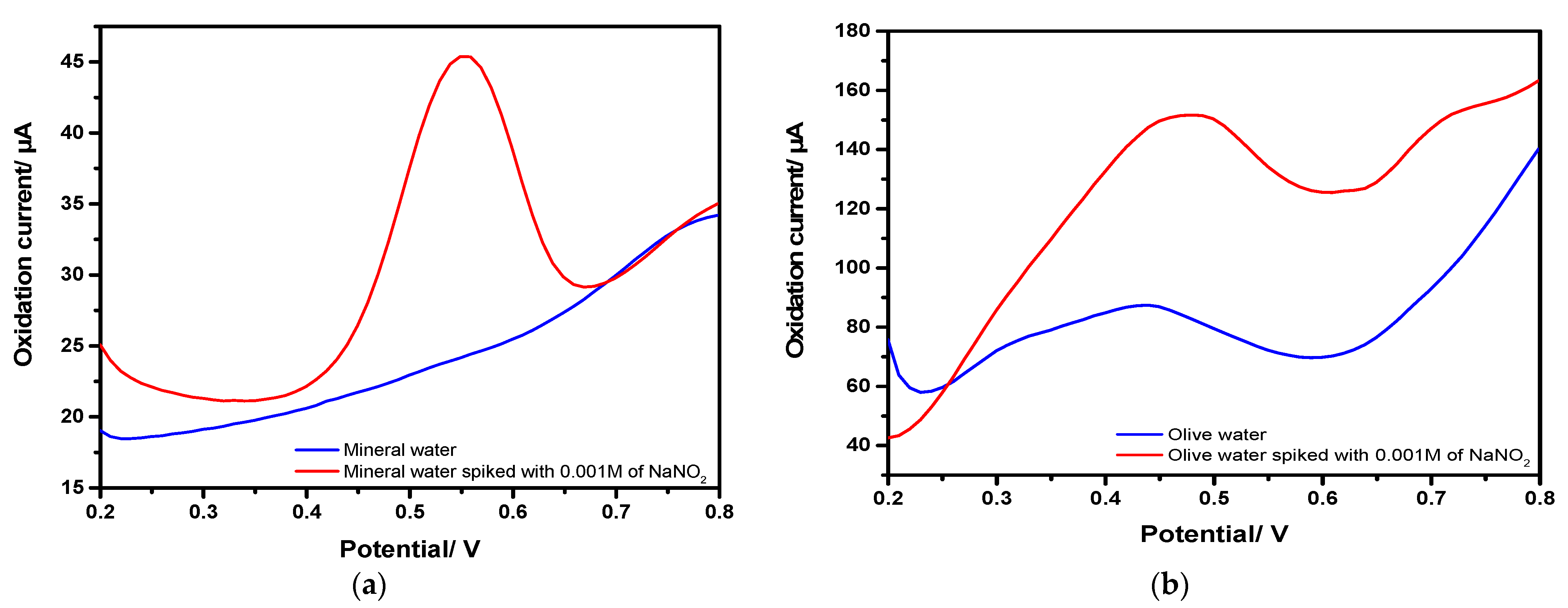
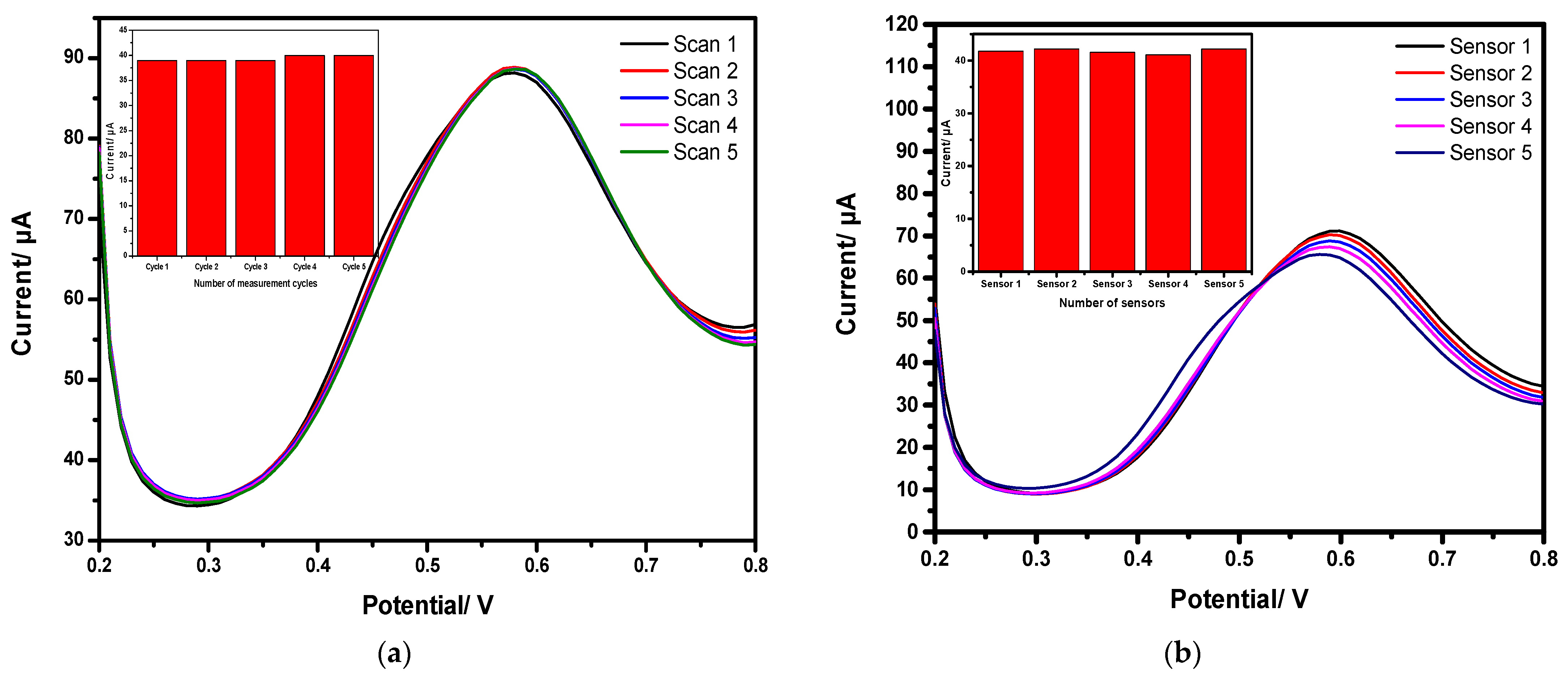
| Electrode | Technique | Linear Range (µM) | LOD (µM) | Ref. | |
|---|---|---|---|---|---|
| AuNPs/rGO a/MWCNTs b | Amperometry | 0.05–2200 | 1.201 | 0.014 | [30] |
| ERGO c/AuNPs | DPV | 1–6000 | 0.3048 | 0.13 | [40] |
| AuNPs-Fe2O3 d | CV | 1–1000 | 0.149 ± 0.01 | 0.07 | [29] |
| AuNPs/MoS2 e/Gr | Amperometry | 5–5000 | - | 1 | [41] |
| Au/ERGO/CuTDPAT f/GCE | Amperometry/DPV | 0.001–1000 | - | 0.006 | [42] |
| β-CD@AuNPs g/GCE | Amperometry | 0.04–1470 | - | 0.014 | [31] |
| Dendrimer/AuNPs-I/GC | Amperometry | 10–5000 | 0.640 | 0.2 | [43] |
| RGO/MnFe2O4 h/PANI | Amperometry | 0.05–12,000 | - | 0.015 | [37] |
| AuNPs/Ti3C2Tx-PDDA i | Amperometry | 0.1–2490 and 2490–13,490 | 0.250 | 0.059 | [1] |
| Fe3O4 j/GO/COOH/GC | DPV | 90–600 | 2.17 | 0.37 | [44] |
| CSPE/AuNPs-PEI | DPV | 0.01–4 | 0.85 | 0.0025 | This work |
Publisher’s Note: MDPI stays neutral with regard to jurisdictional claims in published maps and institutional affiliations. |
© 2022 by the authors. Licensee MDPI, Basel, Switzerland. This article is an open access article distributed under the terms and conditions of the Creative Commons Attribution (CC BY) license (https://creativecommons.org/licenses/by/4.0/).
Share and Cite
Talbi, M.; Al-Hamry, A.; Teixeira, P.R.; Paterno, L.G.; Ali, M.B.; Kanoun, O. Enhanced Nitrite Detection by a Carbon Screen Printed Electrode Modified with Photochemically-Made AuNPs. Chemosensors 2022, 10, 40. https://doi.org/10.3390/chemosensors10020040
Talbi M, Al-Hamry A, Teixeira PR, Paterno LG, Ali MB, Kanoun O. Enhanced Nitrite Detection by a Carbon Screen Printed Electrode Modified with Photochemically-Made AuNPs. Chemosensors. 2022; 10(2):40. https://doi.org/10.3390/chemosensors10020040
Chicago/Turabian StyleTalbi, Malak, Ammar Al-Hamry, Priscila Rios Teixeira, Leonardo G. Paterno, Mounir Ben Ali, and Olfa Kanoun. 2022. "Enhanced Nitrite Detection by a Carbon Screen Printed Electrode Modified with Photochemically-Made AuNPs" Chemosensors 10, no. 2: 40. https://doi.org/10.3390/chemosensors10020040
APA StyleTalbi, M., Al-Hamry, A., Teixeira, P. R., Paterno, L. G., Ali, M. B., & Kanoun, O. (2022). Enhanced Nitrite Detection by a Carbon Screen Printed Electrode Modified with Photochemically-Made AuNPs. Chemosensors, 10(2), 40. https://doi.org/10.3390/chemosensors10020040







